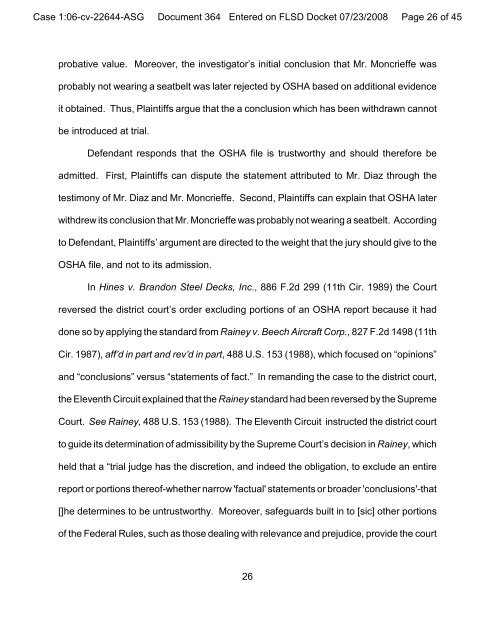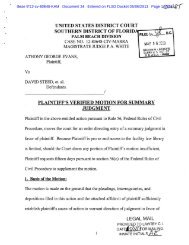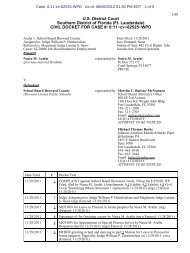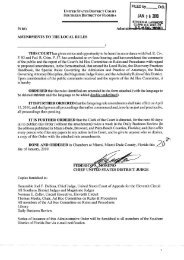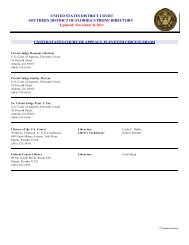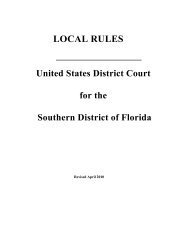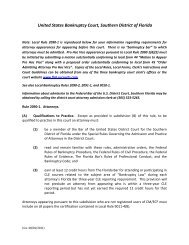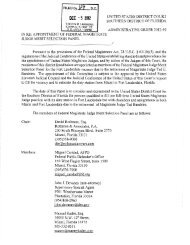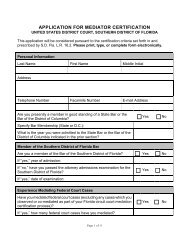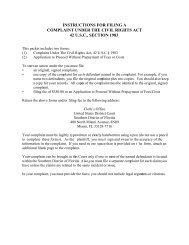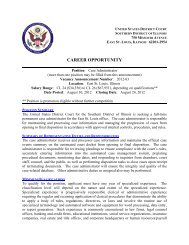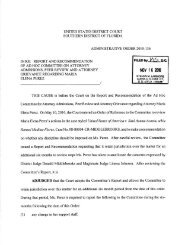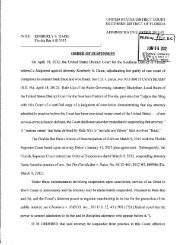Motion in Limine - United States District Court
Motion in Limine - United States District Court
Motion in Limine - United States District Court
You also want an ePaper? Increase the reach of your titles
YUMPU automatically turns print PDFs into web optimized ePapers that Google loves.
Case 1:06-cv-22644-ASG Document 364 Entered on FLSD Docket 07/23/2008 Page 26 of 45<br />
probative value. Moreover, the <strong>in</strong>vestigator’s <strong>in</strong>itial conclusion that Mr. Moncrieffe was<br />
probably not wear<strong>in</strong>g a seatbelt was later rejected by OSHA based on additional evidence<br />
it obta<strong>in</strong>ed. Thus, Pla<strong>in</strong>tiffs argue that the a conclusion which has been withdrawn cannot<br />
be <strong>in</strong>troduced at trial.<br />
Defendant responds that the OSHA file is trustworthy and should therefore be<br />
admitted. First, Pla<strong>in</strong>tiffs can dispute the statement attributed to Mr. Diaz through the<br />
testimony of Mr. Diaz and Mr. Moncrieffe. Second, Pla<strong>in</strong>tiffs can expla<strong>in</strong> that OSHA later<br />
withdrew its conclusion that Mr. Moncrieffe was probably not wear<strong>in</strong>g a seatbelt. Accord<strong>in</strong>g<br />
to Defendant, Pla<strong>in</strong>tiffs’ argument are directed to the weight that the jury should give to the<br />
OSHA file, and not to its admission.<br />
In H<strong>in</strong>es v. Brandon Steel Decks, Inc., 886 F.2d 299 (11th Cir. 1989) the <strong>Court</strong><br />
reversed the district court’s order exclud<strong>in</strong>g portions of an OSHA report because it had<br />
done so by apply<strong>in</strong>g the standard from Ra<strong>in</strong>ey v. Beech Aircraft Corp., 827 F.2d 1498 (11th<br />
Cir. 1987), aff’d <strong>in</strong> part and rev’d <strong>in</strong> part, 488 U.S. 153 (1988), which focused on “op<strong>in</strong>ions”<br />
and “conclusions” versus “statements of fact.” In remand<strong>in</strong>g the case to the district court,<br />
the Eleventh Circuit expla<strong>in</strong>ed that the Ra<strong>in</strong>ey standard had been reversed by the Supreme<br />
<strong>Court</strong>. See Ra<strong>in</strong>ey, 488 U.S. 153 (1988). The Eleventh Circuit <strong>in</strong>structed the district court<br />
to guide its determ<strong>in</strong>ation of admissibility by the Supreme <strong>Court</strong>’s decision <strong>in</strong> Ra<strong>in</strong>ey, which<br />
held that a “trial judge has the discretion, and <strong>in</strong>deed the obligation, to exclude an entire<br />
report or portions thereof-whether narrow 'factual' statements or broader 'conclusions'-that<br />
[]he determ<strong>in</strong>es to be untrustworthy. Moreover, safeguards built <strong>in</strong> to [sic] other portions<br />
of the Federal Rules, such as those deal<strong>in</strong>g with relevance and prejudice, provide the court<br />
26


